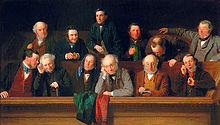
Back الزنابير (مسرحية) Arabic Les vespes Catalan Die Wespen German Σφήκες (κωμωδία) Greek Las avispas Spanish Ampiaiset (Aristofanes) Finnish Les Guêpes French Ealjebijen (toanielstik) Frisian הצרעות HE Vespurnar Icelandic
| The Wasps | |
|---|---|
 The Chorus in The Wasps comprises elderly jurors who briefly resemble wasps in their behaviour (Painting: 'The Jury' by John Morgan 1861, Bucks County Museum, England). The Dramatis Personae in ancient comedy depends on interpretation of textual evidence.[1] This list is based on David Barrett's translation.[2] | |
| Written by | Aristophanes |
| Chorus | Wasps (old men) Boys |
| Characters |
Silent Roles
|
| Setting | before house of Anticleon |
The Wasps (Classical Greek: Σφῆκες, romanized: Sphēkes) is the fourth in chronological order of the eleven surviving plays by Aristophanes. It was produced at the Lenaia festival in 422 BC, during Athens' short-lived respite from the Peloponnesian War.
As in his other early plays, Aristophanes satirizes the Athenian general and demagogue Cleon. He also ridicules the law courts, one of the institutions that provided Cleon his power. The play has been thought to exemplify Old Comedy.[3]
- ^ Aristophanes: Lysistrata, The Acharnians, The Clouds Alan Sommerstein, Penguin Classics 1973, p. 37
- ^ Aristophanes: The Frogs and Other Plays D.Barrett (ed.), Penguin Classics 1964
- ^ Amnon Kabatchnik, Blood on the Stage, 480 B.C. to 1600 A.D.: Milestone Plays of Murder, Mystery, and Mayhem, p. 55.